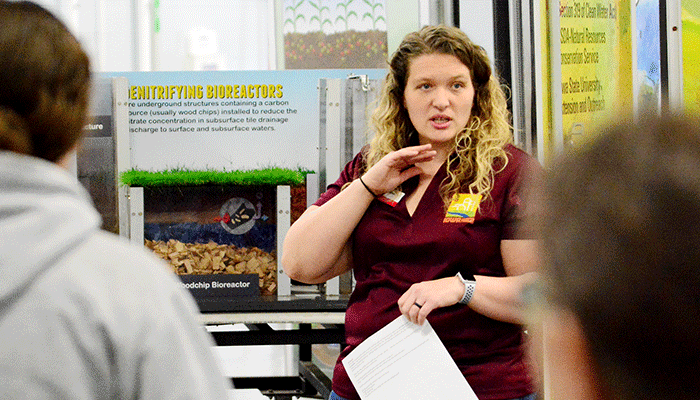Batch and build generating enthusiasm
Author
Published
4/3/2023
Iowa Secretary of Agriculture Mike Naig commended the recent successful “batch and build” conservation drive in Story County that has led to multiple saturated buffer and bioreactor projects underway or in the planning stages.
Batch and build efforts are innovative water quality programs that bring together farmers, landowners, cooperatives and realtors, farm organizations, local governments and the Iowa Department of Agriculture and Land Stewardship (IDALS) to get as many water quality practices on the ground as quickly as possible.
Together, the groups expand and scale up the deployment of proven and cost-effective conservation practices that support the water quality and soil health goals of the Iowa Nutrient Reduction Strategy (INRS), a statewide effort to assess and reduce nutrients in Iowa’s creeks, streams and rivers.
“We’ve never had as many resources, as many partners, as much awareness, as many landowners actively involved in conservation work getting done in the state of Iowa as we do today,” said Naig at an Iowa Learning Farms event in Ames.
“We’ve got more saturated buffers and bioreactors planned in the next three years than were built to date in the whole history of those practices even being established.
“It’s part of an effort to increase the number of saturated buffers and bioreactors. We’re growing, (and) we’ve changed the trajectory of what’s happening in terms of water quality.”
100% cost share
Removing barriers for farmers and landowners considering installation of voluntary water quality projects is a goal of the batch and build master plan. Overall cost savings of up to 30% can be realized when multiple projects are surveyed, engineered and constructed as part of a group project.
All paperwork, including site planning, contractor hiring, government approvals and project funding, is coordinated with a city or county acting as fiscal agent. A 100% cost share is available for the projects during this three-year phase in the central Iowa watershed, with approximately $313,000 available monies in total.
“Part of what we’re trying to do here is build momentum, show success and bring new partners to the table,” said Naig. “This thing has gone from pilot to program in record pace.
“We want to make this very easy for you to say, yes, I’m interested and I’d like to be a part of this, and then we take it from there and make it easy to get this practice done,” Naig said. “One of the neat things about a partnership like this also is it requires entities to say yes to doing something that they’ve never done before.”
Story County projects
Story County Watershed Coordinator Sara Carmichael said their batch and build model has been successful. Currently in year two of the three-year phase, they’re gearing up to sign additional interested farmers and landowners for next year while finishing up surveying for this year’s projects.
The program has grown from five landowners with 10 practices in 2021 to eight projects moving forward with practices among 40 interested landowners in 2022. So far in 2023, 40 letters have been mailed with 12 landowners showing interest.
“We know that these practices are used to reduce nitrates entering our creeks, streams and ditches,” Carmichael said. “The practices work. Depending on the location and the practice, (we see) anywhere from 10% to 92% in nitrate reduction, with an average of 50%.”
In total, it’s an 18 to 24 month process.
“We are able to remove barriers for landowners and take it on as a county or city, taking care of the paperwork and fiscal responsibility,” she said, “working with engineers and the contractors.
“We’re also able to offer 100% cost share with funding (from multiple resources).”
Reducing nitrate loads
Liz Ripley, conservation and cover crop specialist with Iowa Learning Farms, shared educational information with farmers and landowners at the event. She provided hands-on examples of how saturated buffers and bioreactors work to support the denitrification process.
“Saturated buffers are an incredible practice that can help us reduce our nitrate load,” Ripley said. No-till, cover crops, prairie strips and edge-of-field practices such as saturated buffers and bioreactors can help reduce nitrates by as much as 45% to 50% and keep phosphorous in the fields.
“With bioreactors, we’re routing that tile drainage water into a trench … filled with wood chips” where denitrification can take place, Ripley said. The field can be covered with living plant material or even pollinator habitat. “And we can significantly reduce the cost of these installations for you,” she said.
Farmers and landowners wanting to know more about edge-of-field practices and cost-share opportunities can contact Carmichael in Story County at scarmichael@storycountyiowa.gov or visit the IDALS website at www.iowaagriculture.gov.

(Pictured above: Iowa Learning Farms’ Liz Ripley discusses how each of the conservation measures works during a program in Ames.) PHOTO / BOB BJOIN
Want more news on this topic? Farm Bureau members may subscribe for a free email news service, featuring the farm and rural topics that interest them most!